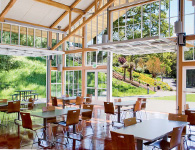Text by Natalya Savka | Photography by Lana Slezic
I e-mail Roy asking if he'll speak with me on Skype.
"But did you speak with Laxman Singh and Bhagwat Nandan and Bata?" he replies.
I write that I'd like to hear from him too, but Roy never responds, thus ensuring that this story won't be about him. In the TED video, he says, "Listen to the people on the ground. They have all the solutions in the world."
***
To inspect the light that won't yet light, Sharma pulls up a stool alongside Moceiwasa. "No light, no go Fiji!" Sharma jokes.
"Light! Fiji!" says Moceiwasa. She flicks her eyebrows up twice, as the Fijians often do to punctuate an important point. Moceiwasa is a farmer's wife and a mother to seven children. Two months ago, in March, she left Fiji for the first time. In mid-September, she'll return with a practical understanding of solar technologies that she'll use to electrify her off-grid village. Maybe one day she'll train other Fijians to do the same.
A few stools down, Yoro Dakou, from Benin, is stripping a wire with her teeth. It must be because her wire stripper has broken or dulled. Moceiwasa says that at the beginning of the program, the two women from Benin would scream and cry, and she couldn't figure out why. No one seems to know what language they speak. In Benin's profile in the college's official records, it says, "Language: No."
The Fijians speak a little English, a result of British colonization, and the teachers speak even less. But after two months of study, all the students and teachers have cobbled together a shared vocabulary: resistance, diode, PCB (though most don't know that it stands for printed circuit board), LED, wire cutter, wire stripper, copper wire, soldering wire, heat sink, connection problem, light. They know colors and numbers in English because colors and numbers determine the placement of circuit components. (Each resistor has four or five color bands, and each color corresponds with a number that represents how many ohms that particular resistor resists, and that indicates which resistor goes where on the PCB. Mess up the placement, and the light won't light.) During the first month of the program, the students and teachers repeated all these words out loud, together, until the names stuck.
In Hindi, the students understand
namaste (hello and goodbye),
garam garam (very hot),
soi soi (very sleepy), and
nacha nacha (dance).
"Connection problem," Sharma says, pointing to the circuit and handing the light back to Moceiwasa, who nods and re-solders the circuit's two connecting wires. Black to black, red to red. She tests it again, and the light turns on. This 12-volt light will connect to a charge controller, which, in turn, will connect to a battery and a solar panel. For a monthly salary paid for by the village, Moceiwasa will install three of these lights and one lantern in her neighbors' houses. If maintained properly, the system should function for more than 10 years, though the battery will need to be replaced every 5 to 6 years.
Sharma coughs.
Moceiwasa turns around to look at her.
Sharma rubs her throat. "Connection problem."
Moceiwasa's forehead furrows. "Problem. Sick." They've understood each other.
***
In a region where child marriage persists and where two out of three women are sent away to tend to their husbands by the age of 18--before they have the opportunity to wonder who they are or who they might one day become--the Barefoot College is breaking tradition. Here, five of the eight solar teachers are women. Sharma, 30, learned solar mechanics in 2009 and began teaching last year. She has "two children, cut-cut," she says, making cutting motions over both fallopian tubes. (To this, Moceiwasa squints and says, "Why?")
Two of the teachers have physical disabilities. I ask teacher Govardhan Gopal if his deformed foot (a result of polio) has brought on challenges, but he does not seem to understand what I'm asking or, maybe, why I'm asking it. In Hindi he says, "This is just how my leg is. It has been like this since I was one." At Barefoot, those with one bad leg use wooden crutches. Those with two bad legs get around using hand cycles and arm strength. Of the college's 200 workers, about 35 are physically challenged.
Teacher Kailash Chand is young and strong and male and 16 hours by bus from home. In his town of Dhanua, Rajasthan, he installed 1,000 lights after training at the college back in 2000. Over chai, Chand leans into the shadow of a neem tree and clicks through his cellphone photos--all of a baby with brown eyes and cheeks so big that they look like they're storing a stack of chapatis. "Vandana looks like me." Vandana and her brother and mother still live in Dhanua, as Chand's father wouldn't let his little granddaughter leave. Chand misses them.
As a textile worker in Dhanua, Chand earned as much as he does now--20 percent above minimum wage, or about $3 per day. (To promote equality, no one at Barefoot earns more than $100 per month.) He says that he is still here, far from his family, because "Barefoot College does good" and did good for Dhanua.
Chand is the one who, from time to time, turns on the TV. Officially, there are no televisions for recreational purposes on campus, but there is the 21-inch television in the southern corner of the solar classroom, beneath a white tablecloth turning sallow from the sun. The TV powers up with a gentle sneeze. All of a sudden, the students are looking at a playing field that's impossibly green--brighter than any desert shrub, jungle green.
"Rugby!" the Fijians say.
It's cricket. Mid-match, Chand turns to the women and asks, "Machli?"
"Machli!" the Fijians yell. Moceiwasa takes off her reading glasses. Chand switches to the Discovery Channel, which is showing a lake. The water is rippling, suggesting moving bodies underneath.
In Hindi,
machli means "fish."
Continue reading >>

Oberlin professor David Orr turns everything emerald.

Ditching the cubicle for a summer outdoors.

Energy efficiency without a big brick box.